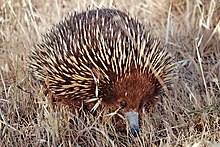
Back نضناض قصير المنقار Arabic ذو المنقار القصير الايكى دنا ARZ Akangol (Tachyglossus aculeatus) AVK Avstraliya yexidnası Azerbaijani Същинска ехидна Bulgarian Ekidne pigos berr Breton Equidna de musell curt Catalan Tachyglossus aculeatus CEB ᎡᎳᏗᏝ ᏙᏒᏓᎵ ᏗᎦᏰᏍᎩ CHR Ježura australská Czech
| Short-beaked echidna[1] | |
|---|---|

| |
| Scientific classification | |
| Domain: | Eukaryota |
| Kingdom: | Animalia |
| Phylum: | Chordata |
| Class: | Mammalia |
| Order: | Monotremata |
| Family: | Tachyglossidae |
| Genus: | Tachyglossus (Illiger, 1811) |
| Species: | T. aculeatus
|
| Binomial name | |
| Tachyglossus aculeatus (Shaw, 1792)
| |

| |
| Short-beaked echidna range | |
| Synonyms[3][4] | |
Genus-level:
| |

The short-beaked echidna (Tachyglossus aculeatus), also called the short-nosed echidna, is one of four living species of echidna, and the only member of the genus Tachyglossus.
The short-beaked echidna is covered in fur and spines and has a distinctive snout and a specialised tongue, which it uses to catch its insect prey at a great speed. Like the other extant monotremes, the short-beaked echidna lays eggs; the monotremes are the only living group of mammals to do so.
The short-beaked echidna has extremely strong front limbs and claws, which allow it to burrow quickly with great power. As it needs to be able to survive underground, it has a significant tolerance to high levels of carbon dioxide and low levels of oxygen. It has no weapons or fighting ability but deters predators by curling into a ball and protecting itself with its spines. It cannot sweat or deal well with heat, so it tends to avoid daytime activity in hot weather. It can swim if needed. The snout has mechanoreceptors and electroreceptors that help the echidna to detect its surroundings.
During the Australian winter, it goes into deep torpor and hibernation, reducing its metabolism to save energy. As the temperature increases, it emerges to mate. Female echidnas lay one egg a year and the mating period is the only time the otherwise solitary animals meet one another; the male has no further contact with the female or his offspring after mating. A newborn echidna is the size of a grape but grows rapidly on its mother's milk, which is very rich in nutrients. By seven weeks baby echidnas grow too large and spiky to stay in the pouch and are expelled into the mother's burrow. At around six months they leave and have no more contact with their mothers.
The species is found throughout Australia, where it is the most widespread native mammal, and in coastal and highland regions of eastern New Guinea, where it is known as the mungwe in the Daribi and Chimbu languages.[5] It is not threatened with extinction, but human activities, such as hunting, habitat destruction, and the introduction of foreign predatory species and parasites, have reduced its abundance in Australia.
- ^ Groves, C.P. (2005). "Order Monotremata". In Wilson, D.E.; Reeder, D.M (eds.). Mammal Species of the World: A Taxonomic and Geographic Reference (3rd ed.). Johns Hopkins University Press. p. 1. ISBN 978-0-8018-8221-0. OCLC 62265494.
- ^ Aplin, K.; Dickman, C.; Salas, L.; Helgen, K. (2016). "Tachyglossus aculeatus". IUCN Red List of Threatened Species. 2016: e.T41312A21964662. doi:10.2305/IUCN.UK.2016-2.RLTS.T41312A21964662.en. Retrieved 19 November 2021.
- ^ Jackson, Stephen; Groves, Colin (2015). "Tachyglossus Illiger, 1811". Taxonomy of Australian Mammals. CSIRO. pp. 38–39. ISBN 978-1-4863-0012-9.
- ^ Iredale, Tom; Troughton, Ellis Le G. (1934). "Genus Tachyglossus Illiger, 1811". A Check-List of the Mammals Recorded from Australia. Australia Museum Memoirs. Vol. 6. Sydney. p. 2. Archived from the original on 10 May 2021. Retrieved 10 May 2021.
{{cite book}}: CS1 maint: location missing publisher (link) - ^ Flannery, T. 1990. Mammals of New Guinea Robert Brown & Associates ISBN 1-86273-029-6
© MMXXIII Rich X Search. We shall prevail. All rights reserved. Rich X Search
